No one ever said to to having an extra bathroom. Here are the steps to install one in your basement with a simple plumbing system.
You will need some tools for this project, lets start with your basic carpenter, electrical and plumbing tools. As for materials, you would need framing lumber, CGCI outlet, PVC adhesive, PVC pipe and Saniflo SaniAcess3.
The additional full bathroom of shower, sink and toilet is a great improvement to any home, especially if you one have on bathroom and a growing family.
With the design of an Upflow bathroom system the plumbing of the basement bathroom, makes this project great for a DIYer. This system includes a macerator/pump that can be tucked into a wall directly behind the toilet.
All the fixture drains flows to the macerator/pump, which solids and then pumps waste upward to connect to your main drain line, instead on gravity. The shower and sink drains to reach the pump, and they are easily installed.
What is a Macetaring Toilet?
The system works similar to a garage disposal in your sink, in a macetaring toilet, waste is channeled to the macetor/pump, which reduces solids to be easily pumped through a 3/4 discharge pipe.
The SaniAccess3 from Saniflo, the system includes a rear-discharge toilet and a macerator/pump with fittings.
System Advantages
The greatest advantage of an upflow system is not breaking up a concrete floor to run floor drains.
The discharge line is much smaller that a standard drain line, so you can fit it into small places. Second, you can install a bathroom anywhere.
We are ready to get started, in 10-steps you’ll have a new full bathroom in your basement.
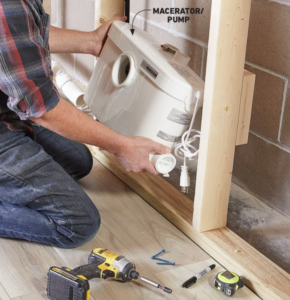
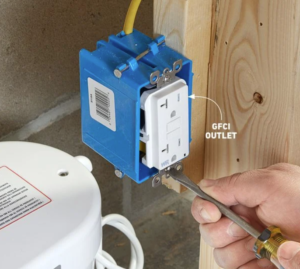
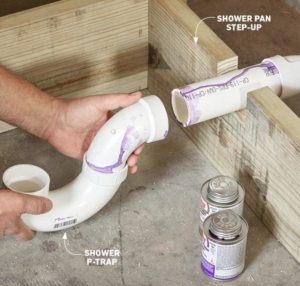 STEP 1: Set the macerator/pump in place behind the wall framing. The unit would need to be at the same level as the toilet. Install the rubber feet and secure the pump to the floor.
STEP 1: Set the macerator/pump in place behind the wall framing. The unit would need to be at the same level as the toilet. Install the rubber feet and secure the pump to the floor.
You would need to allow space between the pump and the wall for insulation, if you are in cold climate. Insulate in front of the pump will help dampen the noise from the pump.
STEP 2: Install the GFCI outlet inside the wall framing, near the pump. The outlet needs to be within 12 inches of an access panel and facing the room.
STEP 3: Building the shower pan step-up. With the shower plumbing in hand, calculate the height of the platform, including the P-traps as well as 1/4″ drop per foot of horizontal run to the pump. The minimum height is six inches, and the that’s sufficient but would depend on your P-trap and the distance to the pump. You may need to add an extra step, depending on the finish height.
STEP 4: Connecting the Shower to the Sink Drain. You’ll need to hook up the shower drain and run the pipe into the wall. Us an elbow turn pipe towards the pump.
STEP 5: Install the vents and connected them to existing vent system. Mechanical vents would work with the system, you would need a free air vent.
STEP 6: Connecting the discharge to the pump by slipping the flexible tube onto its port on the pump and secure it with a hose clamp. Install a shutoff ball valve at the end of the tube. This would prevent backflow if you need to remove the pump.
STEP 7: Connect the discharge to the main sewer line. The easiest place to tie into the main drain is at a cleanout using a reducer fitting. It this is not an option you can install a Y-fitting.
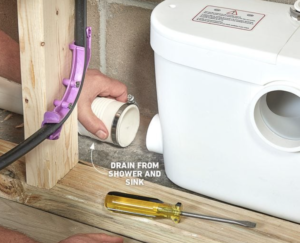
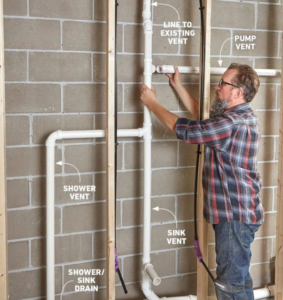
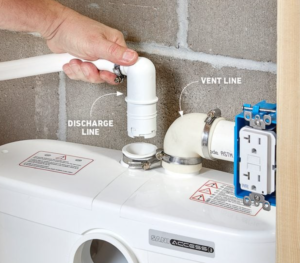
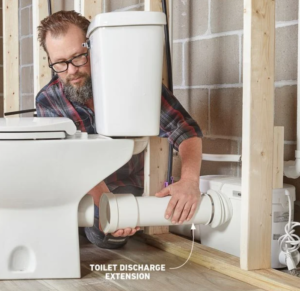
STEP 8: To connect the toilet, set it into position, connect the flexible boot to the toilet’s discharge port. Next, connect the boot on the other end to the pump. Make sure the connection boot faces the right direction. Zip ties keep the boot in place.
STEP 9: Install the toilet. Mark holes on the floor through the holes on the toilet base. Slide the toilet out of the way, then drill holes for the supplied concrete anchors. Slide the toilet back into place and install screw anchors.


